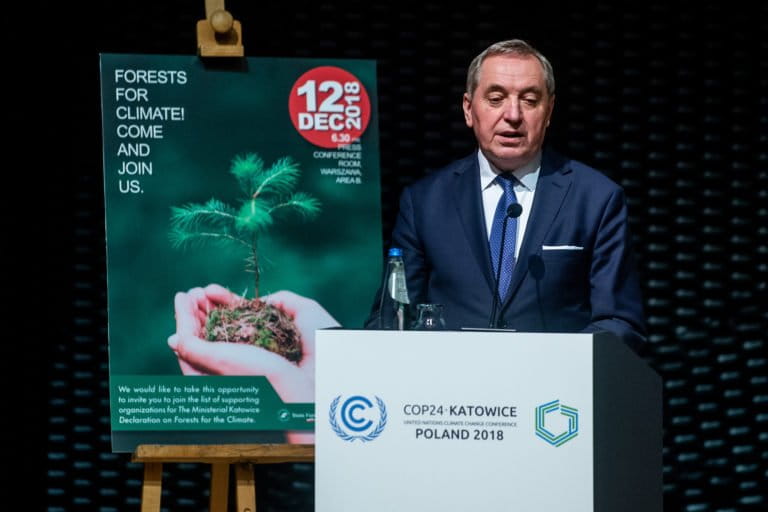- A declaration to protect and use forests as a tool to combat climate change has been lambasted by environmentalists.
- The declaration, initiated by the Polish government during the COP24 climate summit, could promote the burning of wood pellets for bioenergy, the environmentalists warn.
- Wood-based biomass is a controversial and hotly debated topic in climate discussions, with scientists finding it emits up to 50 percent more CO2 than coal. But its proponents, including the U.S. EPA, champion it as a “carbon neutral” source of energy.
KATOWICE, Poland — A plan adopted by delegates at last month’s climate summit in Poland to weaponize forests in the fight against global warming could have a disastrous outcome, environmentalists say.
The Ministerial Katowice Declaration on Forests for the Climate builds on the universal understanding that forests are a key carbon dioxide sink and must be considered a major part of efforts to cap the global temperature rise below 1.5 degrees Celsius (2.7 degrees Fahrenheit) by 2030. Sixty-four countries have expressed their willingness to endorse what’s become known as the “forests for climate” declaration as of Dec. 17, after the conclusion of the summit in Katowice, Poland, with more expected to follow suit.
“We want to show how to strive to achieve a balance between emission and absorption through the application of innovative solutions in the field of forest management, and by relying on the natural process of CO2 absorption by soil and forests,” said Henryk Kowalczyk, the Polish environment minister.
Paola Deda, chief of the United Nations Economic Commission for Europe’s (UNECE) forestry and timber section, said the forest declaration was made not only to keep forests healthy, but also to promote the use of sustainable forest products.
“We have to make sure we have sustainable resources but also making the resources healthy,” she said.
But observers say the wording of the declaration, if not its spirit, presents an opportunity for wide-scale logging — effectively going against the call to expand forest cover to fight climate change.

Call to action
“The role of forest products and forest-related climate actions are the main call to action in this declaration,” Christoph Thies, of Greenpeace Poland, said at a press conference in Katowice. “The forest declaration could turn quickly to be a logging declaration, which will be disastrous for the climate, biodiversity, soil, water circulation and the welfare of the local communities.”
The declaration, initiated by the Polish government, reads, in part: “Further recognizing that forests have a decisive role to play in the sequestration and storage of carbon in the soil, trees and other vegetation, and in providing goods, resources and materials with a smaller carbon footprint, such as harvested wood products.”
What worries observers like Thies is that this emphasis on “forest products” comes in the context of the Polish government’s continued insistence on burning coal as a major energy source — and its advocacy for the increased burning of biomass, i.e. “forest products,” to keep its fossil fuel emissions down.
In 2016, Poland used the United Nations climate talks in Marrakech, Morocco, to promote the concept of “forest carbon farms” that would be developed specifically to serve as carbon sinks. Under the plan, Poland targets increasing its forests’ capacity to eventually absorb about 1 million tons of CO2 from the atmosphere. Currently, one-third of Poland’s land mass has tree cover.
The forest carbon farms are expected to help Poland meet its emissions reduction commitments even as it continues to burn coal.
Greenpeace called the plan a “cheap excuse” and a “PR stunt” ahead of the Katowice summit, Reuters reported. The organization said the plan had little scientific basis and marginal impact in terms of capture of Poland’s greenhouse gas emissions.
According to Thies, the forest carbon farm project will only absorb 10 days’ worth of CO2 emissions from a single coal-fired power plant. Each plant in the country, meanwhile, emits more CO2 per year than the entire span of Poland’s forests can absorb, according to Thies.

Co-firing
The forest carbon farms, and by extension the “forests for climate” declaration, rely on the contentious practice of co-firing. This calls for burning biomass such as wood chips, pellets and even timber in power plant furnaces to cut down on the amount of coal consumed. Poland already does this, even burning nutshells from Brazil, Indonesia and Africa.
The U.S. Environmental Protection Agency (EPA) announced in 2018 that it considered biomass to be carbon neutral for the purposes of regulating emissions from stationary sources, such as power plants. It says forests compensate for the carbon released from burning wood by serving as a net carbon sink.
Proponents of the practice also say wood-based bioenergy is carbon neutral because more trees are planted where the wood was harvested, which offsets the emissions produced by burning the pellets.
But criticism of the practice abounds. Scientists have shown that burning wood as biomass can be worse for the climate than coal because it releases up to 50 percent more CO2 than coal to produce the same amount of energy. It takes decades for trees to regrow and absorb all the carbon emitted from the burning of biomass, throwing into question the carbon-neutral tag.
That didn’t stop Poland, as host of last month’s climate talks, from hosting events on the sidelines of the summit for advocates of biomass burning. The World Bioenergy Forum, organized by the nonprofit World Bioenergy Association, took place on Dec. 5. A high-level side event by the Biofuture Platform, a coalition of 20 countries promoting bioenergy, ran on Dec. 10.
That’s left environmentalists concerned that the forest declaration’s pledge to “accelerate our actions to ensure that the global contribution of forests and forest products is maintained and further supported and enhanced by 2050” is an open call for more wood-based bioenergy initiatives.
This could be held up by countries as justification to continue burning fossil fuels with the rationale that the emissions can be offset by planting trees.
“The forest declaration can’t be an excuse for fossil fuel-addicted countries,” Thies said. “It can’t be an excuse to do nothing with their greenhouse gas emissions. Forests are not an alternative to burning coal, they must go together with quick and just decarbonization.”

Not all forests are equal
Another troubling aspect of the forest declaration is that it sets a deadline of no sooner than 2050 to “achieve a balance between anthropogenic emissions by sources and removals by sinks of greenhouse gases.”
Yet this target needs to be achieved decades earlier, said Otto Bruun, an environmental policy officer at the nonprofit Finnish Association for Nature Conservation. Scientists from the U.N. Intergovernmental Panel on Climate Change (IPCC) warned in a report in November that the world had only until 2030 to halve global greenhouse gases to keep global warming under 1.5 degrees Celsius and avoid catastrophic climate change impacts.
“Action on sinks cannot be delayed for 30 years, similarly as action on mitigation,” Bruun said. “We need to protect and enhance our carbon sinks and carbon stocks starting tomorrow.”
Burning biomass in the meantime will pump more emissions into the atmosphere, where it will accumulate for decades while the trees planted to ostensibly render them “neutral” grow. That leaves the risk that burning forest biomass in large volumes over the short term will cause “even higher emission than burning fossil fuels,” Bruun said.
Even after the new trees reach maturity, their capacity to store carbon will be less than that of the original trees they replaced, thanks to the loss of biodiversity, according to Virginia Young of the Australian Rainforest Conservation Society.
“The more biodiverse natural forests [are], the more secure your carbon stock is,” she said. “Primary forests actually store 30 to 70 percent [more] carbon than logged forests, and they are more resistant to threats, such as pests, disease, droughts, and, critically in the age of changing climate, fire.”
But the “forests for climate” declaration doesn’t acknowledge this, Young said.
“It fails to recognize that not all forests are equal because [it’s] biodiversity that actually conserves longevity of carbon stock in forests,” she said. “So it doesn’t recognize the critical role of increasing protection for primary forest, and focusing restoration around building resilience, increased resistance and stability of our primary forest ecosystem. [It’s] a major gap in the … statement.”

Carbon accounting loophole
Growing trees to harvest for fuel also takes up valuable land, given that biomass burns at just 35 percent efficiency or less — about the same as coal. An area the size of India would need to be converted to industrial tree plantations for bioenergy to provide just 5 percent of global energy demand, according to Souparna Lahiri of the Global Forest Coalition. The land could instead be used more efficiently if protected as a carbon sink or used productively for agriculture, environmentalists say.
And while the burning of wood emits significant volumes of amounts of greenhouse gases, these emissions aren’t counted under the U.N.’s carbon policy, which, like the EPA, treats biomass burning as carbon neutral. The carbon accounting policy was established under the Kyoto Protocol, an international climate treaty adopted in 1997 and a precursor to the Paris Agreement.
Environmentalists called on delegates at the Katowice summit to close this accounting loophole by revising the carbon accounting policy in the Paris rulebook, a technical guideline agreed during last month’s talks for implementing the Paris Agreement. They said the loophole threatened intact forests and the biodiversity living within them by allowing and incentivizing the harvesting of trees to burn for fuel.
Bruun said the European Union was one of the parties trying to address the loophole.
“The EU sets out on this task trying to improve previous accounting rules for forests, trying to close the loopholes of the Kyoto Protocol, which actually lead to a lot of credits in the forest sector with little environmental integrity,” he said.
But the pleas for change fell on deaf ears in Poland, with the agreed Paris rulebook failing to address the carbon accounting loophole.
“The rulebook does not address the biomass loophole, and never really tried to,” said Kate Dooley, an expert with the University of Melbourne’s Australian-German Climate and Energy College. “The best solution would be to remove the incentives to burn bioenergy by counting those emissions, not calling them carbon neutral.”
With time running out to halt a dangerous rise in the global temperature, environmentalists are demanding that world leaders stop treating forests as a resource that can continue to be logged without any consequences to the climate.
“The 1.5-degree limit requires less forestry logging, not more, and [it requires] more forest conservation, not less,” Greenpeace’s Thies said. “People and the planet need forests, not a potentially dangerous carbon offset tool.”
Banner image: Ministers from various countries pose together during the launching of the forest declaration at the 24th U.N. climate talks in Katowice, Poland. Image by Hans Nicholas Jong/Mongabay.














